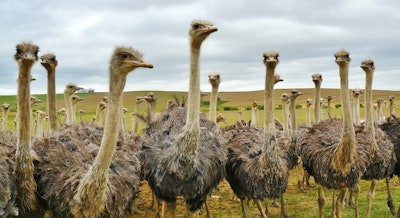
Over the past two weeks, Nigeria and South Africa have reported one and two further outbreaks of highly pathogenic avian influenza (HPAI), respectively, in domestic birds. The latest figures highlight the heavy losses of the disease to the South African broiler and egg sectors, as well as substantial imports to meet local demand.
Following a four-month hiatus, the H5N1 serotype of the HPAI virus has been detected in Nigeria.
The presence of the infection was confirmed during the last week of January after 10 poultry from a backyard flock died, according to the official notification to the World Organisation for Animal Health (WOAH). At the premises in the northwestern state of Kebbe, the rest of the flock was destroyed.
This was the first HPAI outbreak to be confirmed in the West African state since August of last year.
Since Nigeria’s first confirmed cases in the current HPAI outbreak wave in December of 2020, 454 poultry flocks have been hit by the disease, based on WOAH reports. Directly impacted have been more than 2.4 million birds. Cases have been confirmed to WOAH in 31 of the country’s 37 regions (states and the Federal Capital Territory), including previously in Kebbe.
Following news of this latest outbreak, the authorities in the western state of Kwara have warned residents about the threat of HPAI.
According to Daily Post, the state government urged all poultry owners to implement strict biosecurity measures, and to report to officials any signs of illness or elevated mortality in their birds.
For those handling poultry or other birds, a public health advisory note includes advice to use gloves and face masks to minimize the risk of human infections.
2 more HPAI outbreaks in South African ostriches
Latest notification to WOAH from the veterinary authority of South Africa confirm further cases among ostriches at two more farms near to Oudtshoorn in Western Cape. Both were linked to the H5N1 virus variant.
One recent outbreak involved 36 cases out of a flock of 612 commercial ostriches detected in mid-January. Furthermore, 15 birds out of a flock of 1,593 were retrospectively reported to have tested positive for virus in August of last year. Culled were 135 and 26 ostriches at the infected farms, respectively. Both outbreaks are now considered “ended.”
Since the first cases in this outbreak series were identified in April of 2023, presence of the H5N1 virus has been detected at 28 premises across South Africa. Based on information provided to WOAH, these have directly impacted a total of almost 1.8 million commercial birds. These include poultry as well as ostriches, mainly in Western Cape but also in five other provinces.
While no further cases have been registered with WOAH since the end of January, South Africa has also been fighting HPAI on a second front since May of 2023. Notifications received by WOAH so far cover 113 outbreaks linked to the H7N6 virus serotype across eight provinces, and involving around 10.6 million commercial birds.
Among the challenges faced by the nation’s poultry industry is the long delay in compensation payments to some producers whose healthy flocks were culled in order to control the spread of HPAI. This was highlighted by the chairman of the South African Poultry Association (SAPA) in the industry organization’s latest "Poultry Bulletin." The delays have forced some poultry owners to close their businesses.
HPAI impacts on South Africa’s poultry sector
Latest figures from SAPA indicated that on-going HPAI waves have affected 30% of the nation’s broiler breeder farms, with 3.5 million of these birds culled.
Also affected have been more than one-third of its commercial laying hens, including six million culls. Up to four million of the nation’s 27 million hens were quarantined at some point, and losses to the sector in terms of birds, eggs, and packaging materials are put by SAPA at more than two billion rand (ZAR; US$106 million).
As the domestic industry begins its recovery, imports of hatching eggs are approaching 149 million for meat birds, and exceed 2.6 million for egg-layers, according to the same source.
Furthermore, to meet local demand, South Africa has needed to import substantial quantities of egg products.
In 2023 and 2024 so far, these amounted to around 4.5 metric tons (mt) of liquid egg, 474mt of egg powder, and almost 16mt of fresh shell eggs.
Avian flu 'resolved' in Niger, Reunion
Following a single HPAI outbreak in December of 2022 in the West African state of Niger, the disease wave was declared ended in October last year.
According to a recent notification to WOAH, the H5N1 HPAI virus serotype was detected at one farm with around 1,000 poultry in the region of Tillibéri, near to the capital, Niamey. Since then, no further cases were reported.
Two series of HPAI outbreaks linked to the same virus variant have been declared “resolved” in Reunion.
In October of 2022, the territory’s first ever detections of the virus were recorded in one commercial and one backyard flock. In July of 2023, further cases were reported in non-commercial poultry at a second and final location. Directly impacted was a total of almost 600 birds.
An island in the Western Indian Ocean, Reunion/La Réunion is an overseas department of France.
View our continuing coverage of the global avian influenza situation.

















